ChatGPT first appeared at the end of 2022 and quickly transformed different aspects of the educational process. Students harness the perks of this technology for research, essay writing, and even making PowerPoint presentations. Despite its versatility, artificial intelligence still needs to be developed and is far from perfect.
Custom-Writing.org team has created this article to address some of the limitations and disadvantages of ChatGPT that you may encounter when working on academic assignments. During our research, we came across tips crucial for getting the best results!
🤖 What Is ChatGPT?
ChatGPT is an intelligent chatbot developed by OpenAI with the power of advanced natural language processing technology. On a larger scale, it belongs to the family of generative AI tools. Such chatbots transform textual input and turn it into images, videos, or intricate texts through the power of machine and supervised learning.
Many people requiring fast answers, writing assistance, or even coding advice turn to ChatGPT for help.
Students find the OpenAI chatbot especially useful in their academic pursuits, including:
- Essay writing
- Conducting research
- Brainstorming ideas
- Improving their writing capabilities
ChatGPT has access to a vast knowledge database, allowing it to accurately answer questions on various topics. Organizations also actively use this technology for customer service, marketing, sales, and other purposes.
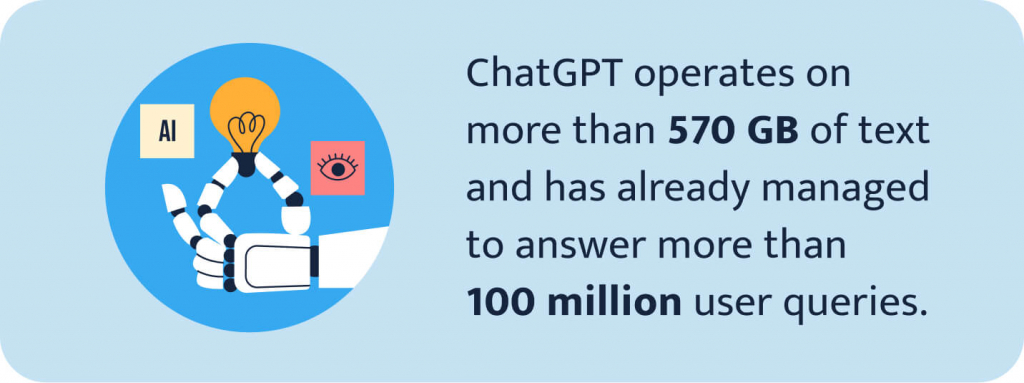
However:
Despite its great popularity, the rise of ChatGPT and similar solutions caused discussions and ethical considerations about its use. Experts, specialists in the field of higher education, and everyday users alike all contribute to this discussion. We will attempt to take a closer look at some of their concerns and offer potential solutions to these problems.
💡 Potential Uses of ChatGPT in Education
The rapid adoption of AI-based tools has transformed how students access information and interact with learning materials. You can generate a poem in the style of your favorite poet or create a PowerPoint presentation.
There are many fascinating methods of utilizing ChatGPT for educational purposes, and here, we’ve described some of the most useful ones.
- Content creation. ChatGPT offers excellent opportunities for students in terms of affordable content generation. Students may use the tool to create essay samples, while teachers could make engaging study materials and quizzes.
- Tutoring and advising. The AI chatbot explains terms and concepts in philosophy, math, chemistry, and countless other disciplines. This gives students a better understanding of a wide range of topics.
- Working on outlines. The AI-powered chatbot can work as an outline maker, providing a fast way for students to structure their papers, essays, and other types of academic tasks.
- Writing assistance. People turn to OpenAI’s product to improve their writing skills, making it more straightforward, engaging, and enjoyable for everyone who comes across it.
- Checking grammar and spelling. Students often use ChatGPT for assistance in upgrading the quality of their work. This platform helps the education process, highlighting grammatical, spelling, syntax, and punctuation mistakes.
- Conducting research. OpenAI’s platform exhibits great potential for researching various topics relevant to academic assignments. ChatGPT eases topic selection, background research, and citation formatting.
- Homework assistance. Students sometimes have trouble understanding concepts or solving problems. OpenAI’s solution provides virtual assistance through analogies, comparisons, and step-by-step examples.
- Creating text summaries. Time constraints pose one of the biggest problems facing modern students. Instead of reading through volumes of textbooks, they can use ChatGPT as a powerful summary generator for all types of written content.
🪄 Disadvantages of ChatGPT + Potential Solutions
Despite the abundant benefits of OpenAI’s chatbot, we must discuss some of the tool’s drawbacks. They vary from AI biases to providing inaccurate information.
This section aims to warn students about the possible dangers of using AI-made content. We’ve also tried to find ways to bypass the limitations of ChatGPT by exploring some tricks.
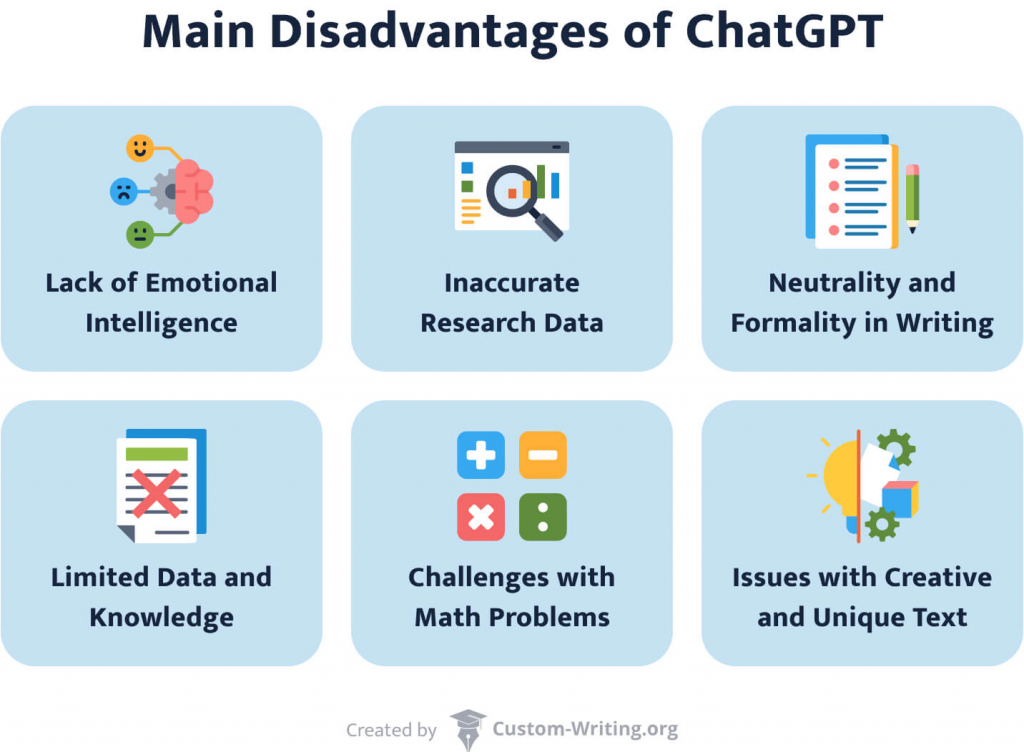
Lack of Emotional Intelligence and Practical Thinking
One of the most apparent problems associated with the ChatGPT tool is that it’s, in essence, an intelligent machine. This makes the chatbot unable to understand human emotions or provide personal opinions.
However:
OpenAI’s product can still imitate texts with emotional coloring. This is how you can add emotional depth to your text:
- First solution. Write a request that includes the emotions you want the AI to have about a particular topic. For example, you can ask ChatGPT the following: “Write a 500-word, 4-paragraph text about the tragedy of gun violence in America to educate people about the dangers of uncontrollable selling and buying of firearms.”
- Second solution. Give ChatGPT an example of an emotional or opinionated text.
AI Responses: Examples of Good & Bad Prompts
Let’s look at how you can turn a ChatGPT disadvantage into a benefit with the modified prompt to get a better-structured text. Here, we’ll show how to adopt the first solution.
What’s Wrong with the Initial Prompt?
The initial request doesn’t produce the expected result due to the following reasons:
- ChatGPT has no context, so it wrote neutral text.
- The prompt doesn’t provide your attitude towards the topic.
As a result:
- The text does not convey the writer’s emotions and personal experiences.
- It looks plain and more suitable for an informative essay than a narrative one.
Limitations on Creating Unique and Long Content
While ChatGPT generates coherent and grammatically sound sentences, it needs help with long-form texts. The AI tool is notorious for using repetitive sentences, words, and phrases, making the result sound dry and cumbersome.
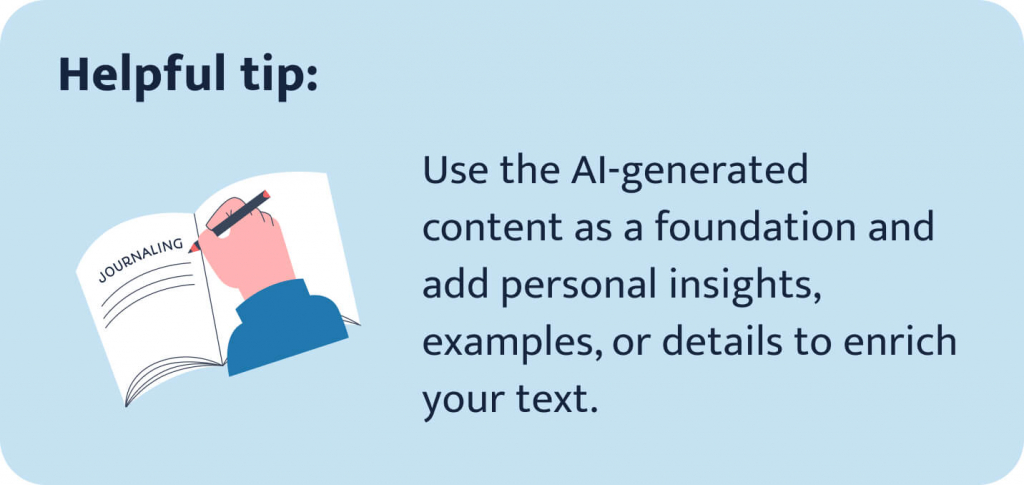
- First solution. One of the best ways to address these disadvantages of ChatGPT is by editing its drafts and making them more personal. While it takes longer to refine, it guarantees that the resulting piece of writing is uniquely yours.
- Second solution. Include additional details in the prompt. That’s what you could add: “Tone: conversational, use less technical jargon.” These details would also help to have the chatbot generate several responses to work with.
AI Responses: Examples of Good & Bad Prompts
In the examples below, you’ll see how the text is transformed after supplementing your request. Our second solution makes the modified result more engaging and unique.
What’s Wrong with the Initial Prompt?
We didn’t get unique and engaging content. Here are the main reasons:
- The chatbot doesn’t know what functions the content should accomplish.
- We didn’t specify the intent.
- We didn’t provide the writing style.
As a consequence:
- The text is boring and won’t hook the reader.
- It features a formal writing tone.
- The sentences are overly long.
- Specific terminology makes the text difficult to grasp.
Inaccurate Research Data and Untrue Responses
Another area where ChatGPT lacks is providing inaccurate data and faulty responses. This is because the large language model (or LLM) uses surrounding context to add words to the answers that are statistically more probable. These Chat GPT limitations make its answers sound plausible while actually being nonsensical or completely incorrect.
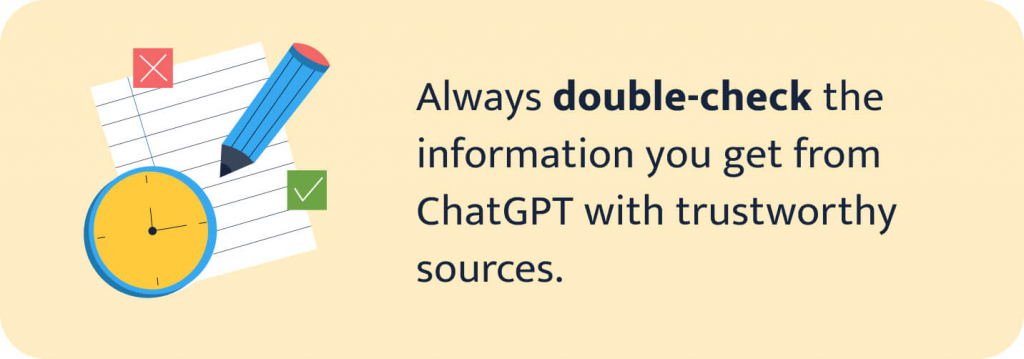
The most sound thing to do is to check every fact and statistic the AI solution provides. Failing to do so can make your academic papers factually outdated or contain falsehoods that devalue them entirely. Several methods help them overcome this drawback:
- First solution. To get more accurate data, students should provide additional context. This information helps ChatGPT better understand requests and provide more relevant answers. Explain background information, refer to previous parts of the conversation, and remove any assumptions to make questions less ambiguous.
- Second solution. It’s possible to get more accurate answers by clearly stating your topic, task, and research field. Also, you can ask for a particular tone of voice.
AI Responses: Examples of Good & Bad Prompts
Here, we’ve shown how an incomplete or inaccurate prompt can affect the quality of the chatbot’s answer. You may receive a text that is completely unrelated to your topic.
What’s Wrong with the Initial Prompt?
What went wrong here? These are the reasons for an irrelevant response:
- The prompt lacks context.
- There is no background data.
- The research topic is not fully specified.
As a result:
- The text describes a completely different research field and topic.
Neutrality and Formality in Content Writing
This problem comes back to the limitations of ChatGPT we’ve mentioned from the start: ChatGPT has trouble imitating emotional language and human ways of thinking. Because of its nature, the chatbot produces neutral, formal texts devoid of a personal touch. OpenAI’s product poorly understands humor and sarcasm, making its output as riveting as reading a shampoo bottle.
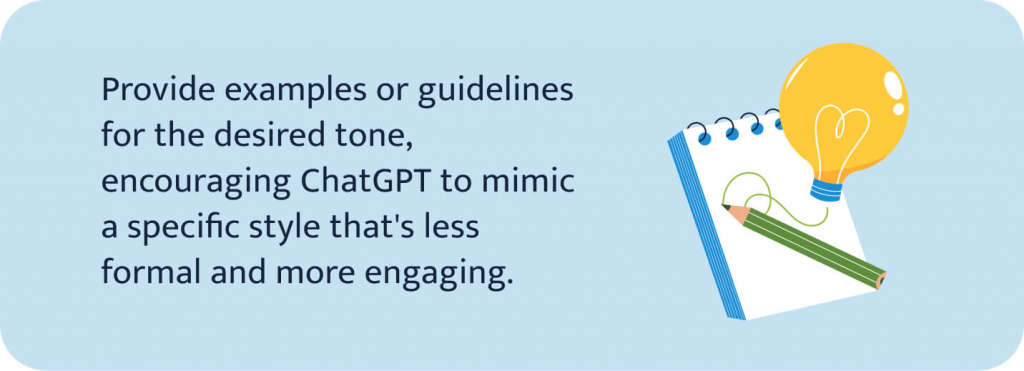
- First solution. Students deal with this situation and make their papers more engaging by sprucing them with the abovementioned elements. Ask ChatGPT to tell a joke or a personal anecdote and use some humor here. The result will sound less robotic.
- Second solution. You can request to add literary techniques such as metaphors and comparisons. However, don’t go overboard—use them only when the situation demands it.
AI Responses: Examples of Good & Bad Prompts
This section demonstrates that with the right approach, you can generate text that comes very close to being created by a human writer.
Check it out:
What’s Wrong with the Initial Prompt?
Let’s figure out what’s missing in the initial request. Here are the main shortcomings:
- We didn’t specify the tone of the text.
- We didn’t ask to make it hookier.
- The prompt doesn’t indicate what impression the piece should make on the reader.
As a result, ChatGPT generated us:
- An overly formal text consisting of unnecessarily long sentences.
- A piece that is not engaging to read and won’t resonate with the audience.
Limited Data and Knowledge
Previously, OpenAI’s solution used data uploaded to the internet before September 2021. After a comprehensive training process, its datasets provide information dating to January 2022. Sadly, it still doesn’t give information about more recent events.
Despite these limitations, you may promptly explore modern sources with a simple trick. All you have to do is provide the chatbot with a list of facts from the appropriate article. Besides, you can use our main points generator to make the perfect list.
For example, when writing an article about the ethical concerns of cardiac surgeries, generate a list from the text about relevant debates on this topic and ask the ChatGPT tool to use that information to write an essay.
ChatGPT: Language Model vs. Math Problems
Regardless of the wide applications and great results provided by artificial intelligence, this technology has another notable problem: it’s lousy at math. These disadvantages of ChatGPT lie with the inherent structure of LLMs and modern computers. Machines receive strict instructions for different actions, while ChatGPT and similar chatbots use a large language model to function.
While this structure allows the AI-based chatbot to learn constantly, it doesn’t seem interested in learning about or solving complex math problems. When asked to perform this action, the conversational AI product tells users it’s not built for this purpose. However, it handles itself pretty well when working with simple things like addition, subtraction, or division.
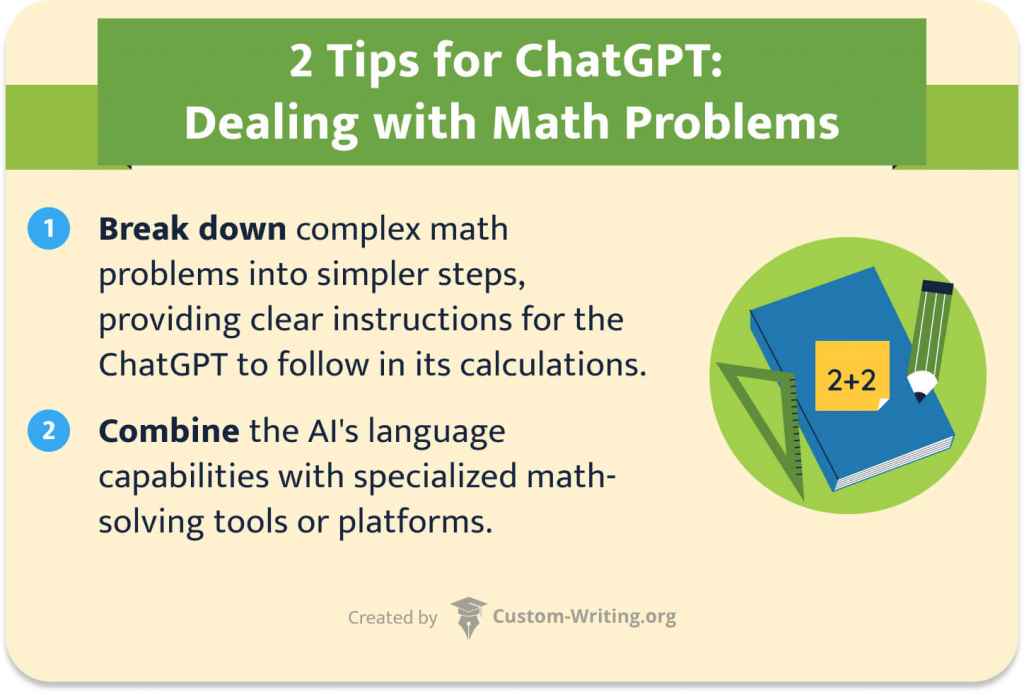
It will give the right answer if you ask it to subtract 20 from 200. In some cases, the artificial intelligence solution may solve trigonometry problems and comprehend the system of linear equations. However, there are several types of tasks ChatGPT has trouble solving.
- Prime numbers. The chatbot seems to act strange regarding this concept, as it thinks that 0 is a prime number. However, it does well regarding basic division with prime numbers.
- Word problems. This conversational AI product requires volumes of context and narrowing down to solve word problems. This process takes some time to fine-tune, with varying results.
- Fractions. Another area where OpenAI’s solution has trouble is fractions. The chatbot fails to understand this concept and solve problems where it’s used.
- Decimals. The chatbot shows serious problems with decimals. It mostly gives false answers, with a few exceptions.
- Multiplication. While the ChatGPT tool handles basic multiplication tasks easily, trouble starts when decimals are involved. The solution needs more information and training to solve such problems successfully.
- Geometry. The chatbot also needs to improve its skills in solving geometry-related tasks because it has difficulty perceiving space. Hence, it is challenging for ChatGPT to understand the parameters of different geometric figures.
- Advanced math. Lastly, Chat GPT limitations make it perform poorly with advanced mathematical problems like quadratic equations. It struggles when basic multiplication and addition are used in the same task.
And how do you address these problems? The answer lies in self-education. If you need assistance with these concepts, check out alternative tools or plugins like Wolfram Alpha. It also never hurts to ask tutors or teachers for help or to solve problems independently.
🤔 Limitations of ChatGPT: Why AI Cannot Replace a Human
Despite the heated discussion that’s going on the web, it’s a bit early to say that AI will ultimately replace human intelligence in its current state, as it has shortcomings. We’ve dedicated this section of our article to specific limits of the chatbot you may face with little chance of avoiding them. These artificial intelligence tools, like ChatGPT, currently lack in several areas:
- New concepts and insights. Like all popular LLMs, ChatGPT can’t create new ideas and provide fresh insights into existing ones. It only works with available data, making the solution unsuitable for forecasts.
- Sense of humor. OpenAI’s product is an advanced robot that writes like one. All of its works read like a job description or vacuum cleaner manual, without a hint of humor or satire in sight.
- Figurative phrases. The AI-powered chatbot has trouble comprehending metaphorical expressions like “being hit by a ton of bricks.” We recommend avoiding their use in prompts and sticking to plain language to ensure the chatbot understands you clearly.
- Multilingual capabilities. While ChatGPT shows fluency in English, it needs help with users from whom this is a second language. This is especially true for native terms, expressions, or words.
- Security issues. Another major concern is that the conversational AI solution doesn’t keep personal user data private. We advise you to refrain from sharing any confidential details with ChatGPT.
- Political debates. Due to the chatbot’s neutral programming, it never takes sides in political topics and discussions. Instead, the solution gives users a rounded opinion of various issues and policies.
- Multitasking abilities. The chatbot only works with one task at a time. When asked to multitask, the tool slows down without answering all questions. But you can open several tabs and ask ChatGPT for entirely different or connected prompts, and it’ll answer all of them.
⚡ 15 Helpful Tips to Overcome Chat GPT Limitations
Here, our experts have gathered effective strategies to improve your prompts and get more productive results from ChatGPT. Adopting several of them will enhance the quality of interactions with this AI-based chatbot. Besides, be sure to check your generated content with the AI text finder before submitting or publishing it.
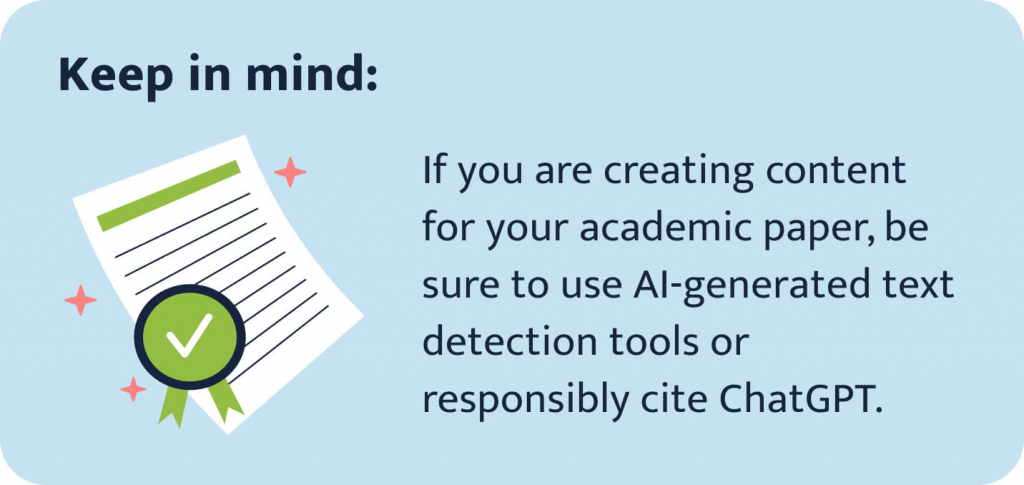
Take a closer look at each of them:
- Specify the content format. When interacting with ChatGPT, ask it to frame responses in a particular format. For example, request the chatbot to present information in bullet point lists and tables in an ascending or descending pattern.
- Use prompts. OpenAI’s solution produces excellent results when asked to write content based on prompts. There are plenty of prompts for students to find on the web that will help finish academic writing assignments faster.
- Set word and sentence counts. Written tasks usually have guidelines for the number of sections, paragraphs, sentences, and words. Specify these parameters to get fast results and leave more time to polish the work.
- Include keywords. When working on texts with the help of ChatGPT, add relevant keywords to your queries. This helps better comprehend requests and provide more accurate results. If you don’t know which to use, plenty of keyword-maker tools can help you out.
- Engage your manners. While OpenAI’s solution doesn’t have human emotions, it never hurts to be polite when using the platform. The chatbot asks users to be respectful to make interactions with the model more positive and productive.
- Think about your audience. During your work with ChatGPT, tell it about the target audience of your writing. The solution may be to use more technical terms when making content for academics or keep things simple if the paper is intended for a general audience.
- Be clear and concise. Use this rule when working with ChatGPT: the tool won’t work as well if a person can’t understand what you’re asking them about. Structure questions clearly and concisely, leaving no room for misunderstanding or misinterpretation.
- Analyze and validate. As we’ve mentioned before, never take the information provided by this conversational AI tool at face value. Carefully review the content for accuracy and relevancy. Provide only the necessary facts and delete everything irrelevant.
- Ask for rephrasing. If some lines sound boring or robotic, asking the tool to rephrase them or the entire text is always possible. ChatGPT works excellently as an essay paraphraser and will give as many responses as necessary.
- Think creatively. When working with the platform, think outside the box and experiment with prompts and their composition. This improves your creative thinking and helps you find new approaches for particularly dull assignment topics.
- Check for plagiarism. While ChatGPT creates volumes of content, there’s no guarantee it’s unique. You should remember this and run your texts through Grammarly and similar platforms for signs of plagiarism. It’s also important to remember to cite the information used properly in your academic papers.
- Copy and paste content from other resources. If you’re in a hurry, copy-paste text from different resources and have the chatbot explain its meaning. It’s a great way to summarize works or have ChatGPT relay its main points.
- Select relevant examples. When the chatbot doesn’t understand what you’re asking, provide it with text samples of the same questions from other sources. It’s also possible to give ChatGPT additional info for clarification.
- Ask for supplemental materials. OpenAI’s solution helps students better understand different concepts and methods. It’s always possible to ask the chatbot for more information and study materials on various topics.
- Provide feedback. When receiving an incomplete or inaccurate response, politely tell ChatGPT why the answer didn’t satisfy you. This process aids the tool in learning and improving its performance with each interaction.
We’ve tried to cover all problematic aspects of using AI that students should be aware of. After all, despite the creation of many other AI chatbots, ChatGPT remains in a leading position. Try our tips and strategies to make your experience with ChatGPT more pleasant. Also, check out our beneficial guide on the best AI tools for students!
Check out other excellent materials about ChatGPT and similar AI tools:
- ChatGPT Essay Examples
- Can I Get Caught Using ChatGPT?
- Is Using ChatGPT Cheating?
- Best AI Detectors for Students in 2025
- How Do AI Detectors Work?
- Best AI Tools for Homework in 2025
🔗 References
- ChatGPT in Education: What Is ChatGPT Capable of, and What Are Its Limitations? – Dr. Laura Koenders, Davitze Könning, Utrecht University
- The Limitations of Chat-GPT. – Avinash Saravanan, Medium
- How to Use ChatGPT to Make Your Work More Efficient (with Prompt Examples). – Taylor Haynes, Indeed
- The Top 10 Limitations Of ChatGPT. – Bernard Marr, Forbes
- What Is ChatGPT and Its Uses? – Eaton Business School
- 23 ChatGPT Limitations that You Must Be Aware of. – FutureAIPrompts
- Unleash the Power of ChatGPT with these 20 Use Cases. – Emeritus
- 12 Ways to Get Better at Using Chatgpt: Comprehensive Prompt Guide. – Aaron Mok, Insider
- How to Write Better ChatGPT Prompts for the Best Generative AI Results. – David Gewirtz, ZDNET
- ChatGPT and Education. – Board of Trustees of Northern Illinois University



